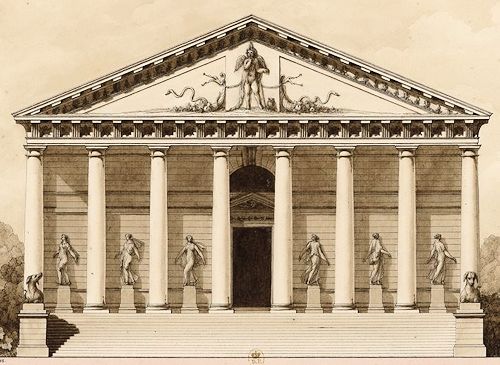LeDeuzzy, Q. |
I believe in multiple choice |
|
|
|
Jean-Jacques Lequeu was born at Rouen on September 14, 1757. His father, Jean-Jacques-François seems to have been a cabinet maker or a designer of furniture, with some interest in landscape architecture and in architecture itself. Scattered among the collection of drawings by his son in the Bibliothèque Nationale in Paris are several by the elder Lequeu: a mantelpiece, signed and dated 1745; a sideboard with Rococo carving, signed and dated 1750; two portals for the palace of an archbishop, dated 1766; the layout of a garden; the elevation of a monumental terrace building representing, apparently, the temple of Fortuna at Praeneste, and others. |
The younger Lequeu was to follow the father in his various activities but with this difference, that architecture played the major role in his life, interior decoration the minor. As a pupil of the school of design at Rouen, he was awarded prizes in 1776 and 1778. The director of the school, the painter Jean-Baptiste Descamps the elder, was favorably impressed by Lequeu's ability and wished him to carry on his architectural studies in Paris. Descamps persuaded the artist's uncle, a priest, to grant the young man a twoyear pension and Lequeu went to the capital in 1779.
| In 1779, perhaps still before his journey to Paris, he tried his hand at a large architectural project, a town hall for Rouen, which later brought him recognition in his native town. |
|
|
|
It must have been in the early seventeen-eighties that he made the Italian tour with the Comte de Bouville. He mentions it in a little note, and several drawings also testify to this journey. One carries the legend "al campidoglio," another "Nella villa Medici," and a third, "Candelabre antique à Ste. Agnèse." The "Progetto . . . del Grande Padiglione Italianamente" (sic) is dated 1783. Back home, in 1786, Lequeu, though living in Paris, was nominated adjoint associé of the Académie Royale des Sciences, Belles Lettres et Arts de Rouen.
|
About this time he was still employed by Soufflot, "dit le Romain" (as he describes him to distinguish him from the architect of the Panthéon). When the younger Soufflot carried out the Hôtel Montholon on the Boulevard Montmartre, Lequeu was "a draughtsman and inspector" under him, providing also designs for furniture.
|
He also states that he was the Chef de l'un des ateliers publics in the faubourg Saint-Antoine in 1790 and 1791 and that he took part in the preparations for the first great revolutionary festival, the Fête de la fédération on the Champ-de-Mars, on July 14, 1790.
|
Quondam © 2020.01.01 |





